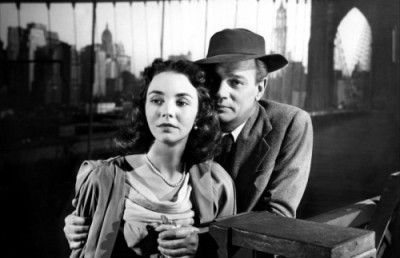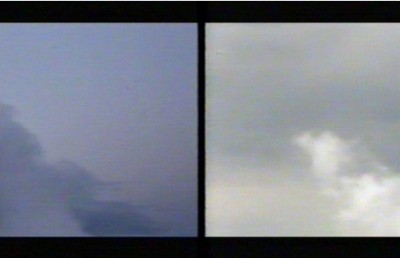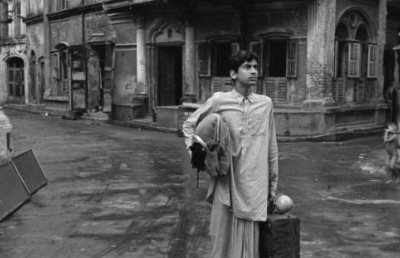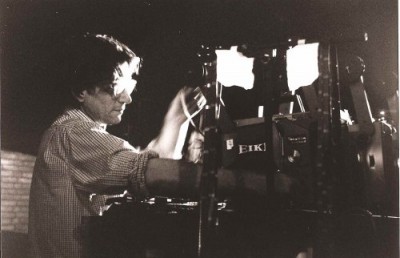Destroyed Cinemas
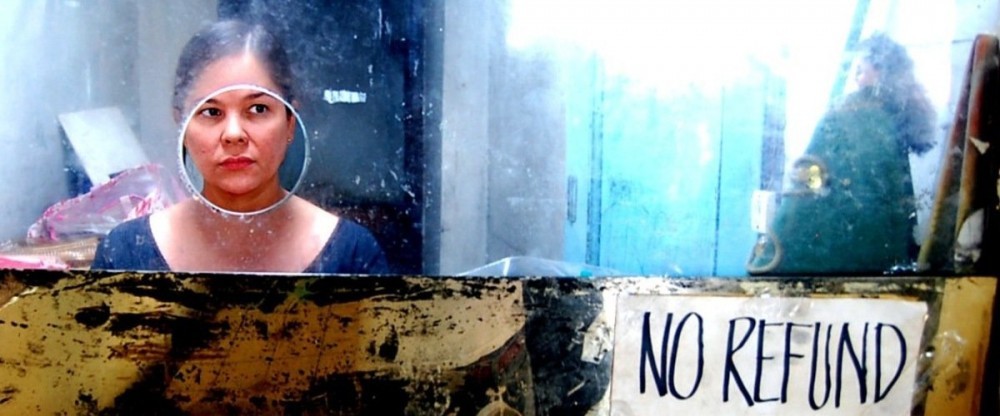
The cinema space in Brilliant Mendoza’s film Service (Serbis, 2008) is constantly besieged by secret sex acts and the deafening commotion of the city. His film nests a family melodrama within the twisted, ornate labyrinth of a collapsing art deco cinema in central Manila. Domestic domiciles are squeezed above, under and in front of the space of projection; the pubescent daughter spied on by her younger brother as she poses nude in front of a cracked mirror, whispering “I love you, I love you” while clumsily smearing red lipstick on her lips; her older projectionist sibling pisses in a plastic coke bottle and has sex with transvestites during screenings, another older sibling fashions a makeshift studio in a storage space for old 35mm film prints, creating large scale erotic paintings while constantly picking at a bleeding boil on his buttock that is about to burst. Manila’s urban cacophony frames the story, dialogue is drowned out by the noise, pollution fogs up the frame. The Cinema the family runs is almost bankrupt. They resort to showing erotic, soft pornography to clientele who are mostly gay men who use the cinema as a space to pick-up hustlers. When we enter the decrepit, crumbling space of projection, the sounds of the city are absent. No one is sitting, they drift through the aisles, lean against the back wall, rarely watching the screen. The projected image serves as an ambient lantern to help them seduce and solicit the Service of real sex, in front of the filmed, dramatized sex on screen. At the film’s conclusion, an orgy is interrupted by a goat who enters through a hole in the crumbling theatre’s outside wall. House lights are flashed on, pants buttoned up hastily, panic ensues. Hustlers and their customers escape down the ornate stairs of the crumbling cinema, into the natural light and chaotic noise of the street outside.
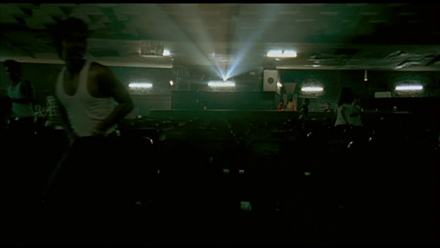
Serbis
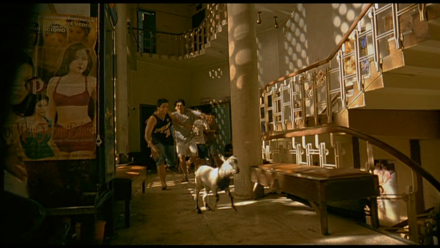
Serbis
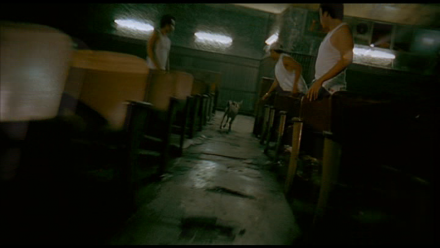
Serbis
Cinema was created by the city, an architecture inspired by and modelled to balance the emancipatory anonymity and voyeurism of the metropolis. It is a space abstracted from the city to fulfil an emerging desire for clean, mediated, emotional catharsis. The darkened cinema was the perfect venue to provide a solipsistic poetic spectacle that reinforced the emerging social codes of these new megacities. George Simmel’s “The Metropolis and Mental Life” argued for a physiological analysis of how the migration from small, close-knit communities to big cities changed us. The blasé disposition nurtured by the metropolis is a consequence of the reduction of all relationships into abstracted, qualitative means to an ends for monetary exchange. We are, according to Simmel, creatures of difference. The emerging metropolis overwhelmed us with an ocean of difference, so to compensate, we developed a “correct subjective reflection of a complete money economy to the extent that money takes the place of all manifoldness of things” 1 The intellectualistic character of these new communities becomes punctuality, calculability, and exactness. 2 In short, the rational was preferred over the irrational, the external more trustworthy than the internal.
With the compromising of physical space in the crowded city, Simmel claims that for the first time, the expansion of intellectual space could be perceived. This retraction from a perceiving body of instinct (smaller villages, familial relations) to an abstracted body defined by capitalistic exchange forced an inward turn. The city fostered a form of Cartesian dualism, bodies numbed as a means to deal with the shock of difference and lack of space in the city. Thus, the architecture of the cinema was designed to satiate a disembodied form of entertainment, a cinematographic cocoon, a dream-space for reflection and self-assessment. This design, in opposition to the Greek Agora, or the town market square, presented a new, disembodied means of assessing and engaging with a representation abstracted from the real world as a frozen strip of nitrate film.
“It is because I am enclosed that I work and glow with all my desire.” This is Roland Barthes’ apology for the structure of the cinema; the inoccupation of bodies, constricted, watching the film together, watching the film alone. According the Barthes, “The inoccupation of bodies, which best defines modern eroticism — not that of advertising or strip tease, but that of the big city.” 3 Without the city and the physiological affects on our psyche, there would be no need for the cinema. Mediated emotion, in the dark we share nothing, crying and laughing alone. The screen-space sculpted by mise-en-scène satiates our need for an intellectual-space that does not necessitate touching, aroused bodies. Keeping the city out, offering a space of protection, a meadow for the mind to wander. Enter the goat, awkwardly stumbling through a decrepit cinema. The screen is ignored, groaning sex sounds sculpt the darkened space. Finally, the goat jumps in front of the screen, images projected onto its scraggly white coat. The sex abruptly stops. People in the cinema look up at the screen for the first time. As the house lights flash on we are reminded that this is in fact a moment that describes the death of the cinema. The city has infiltrated the sacred space of projection, bodies have revolted against their incapacitating postures, sex has redefined the space of the cinema as a means to re-imagine bodies, anonymous touching verses anonymous viewing. Our bodies have broken down the walls of the theatre; enter the goat.
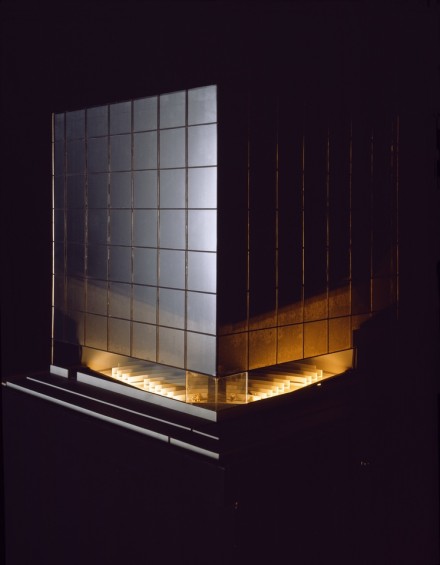
Dan Graham’s Cinema (1981)
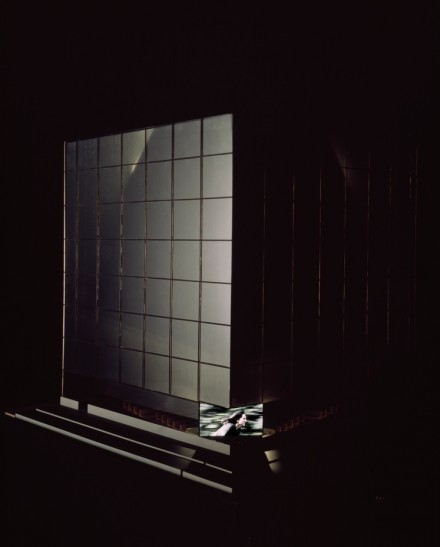
Dan Graham’s Cinema (1981)
Dan Graham’s Cinema (1981) is a maquette that proposes an architecture that deconstructs immersion in the projected image by utilizing two-way mirrors for its facade and screen. It was inspired by Johanes Duiker’s Bauhaus/Constructivist design of the Handelsblad Cineac, a cinema built in 1934 in Amsterdam.
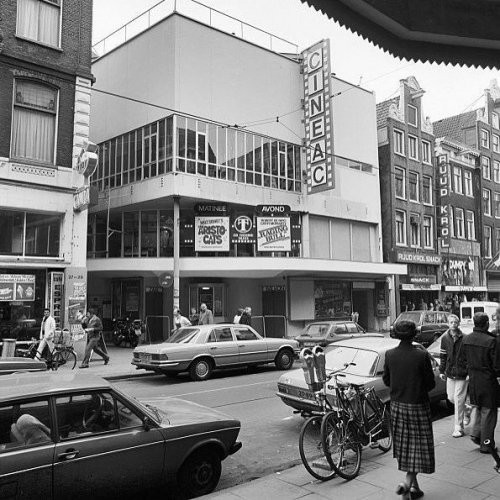
Cineac
In Duiker’s Cinema, various levels of the corner facade were removed and replaced with glass, exposing the lobby, projection booth and seating in the upper balcony. It is an architecture which aimed to demystify the technology and transfixation of the image by literally exposing the architectonics and apparatus of projection to the pedestrians on the street. Dan Graham’s theatre is an inversion of Duiker’s cinema. Rather than exposing the mechanisms of projection and production, Graham plays with oscillating perspectival systems.
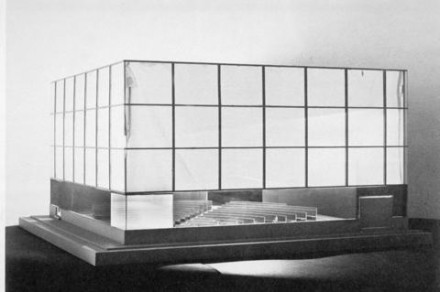
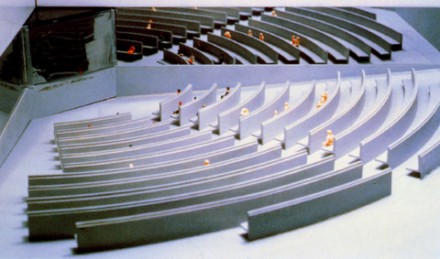
When the cinema is dark, the viewers watch the film and the pedestrians outside. The screen, also a two way-mirror, hangs eye level. During screenings, pedestrians would see both the projected image through the mirrored facade, and the frontal gaze of the spectators when the light-cone bounces off the mirror-screen, back into the theatre. When the house lights are up, the spectators become aware of their bodies, “the screen and sides of the theatre become literal mirrors (as opposed to the illusory ‘mirror’ of the film), reflecting real space and bodies and looks of the spectators.” 4 Graham’s architectural proposal would create oscillating perspectives; an anonymous surveillance of spaces outside the cinema with an awareness and self-monitoring of a spectators’ subjectivity, their presence in the cinema. It displaces traditional notions of viewer and viewed, and augments singular projected duration with a lived duration of walking in the city.
Graham’s opening of the cinema with a set of architectural proposals inspired our experimentations with the Situated Cinema Project. Five iterations of the Situated Cinema Project (2011-2015) reconfigured 16mm projection spaces as temporary, mobile and as an intervention of art in public space. I created this work with a fluctuating set of collaborators, intending to create alternative haptic situations when engaging with experimental film. Situated in city spaces across Canada, an uncanny architecture would appear temporarily. The project invited spectators to enter a space designed to create enough darkness to mimic an actual cinema, but with a screen that was repositioned with mirrors to create alternative encounters with celluloid images. All iterations of the Situated Cinema Project included 16mm loops that were produced using artisanal filmmaking process such as hand-processing and optical printing. The film material contained chemical improvisations that were embedded in the skin of the film, thus drawing attention to the material conditions of the celluloid. Inspired by haptic encounters with experimental film in traditional cinema spaces, we focused on repositioning and experimenting with projection in order to emphasize both the surface of the film and a spectators’ ability to literally touch the light. This expanded tactility created an encounter with the projected image that was both haptic and topographical. Rather than sitting and being touched by a light cone in a traditional theatre, viewers walked through an experimental, temporary exhibition space. The projected image is flattened and the light cone redirected onto a surface that is approached, encountered, analyzed as one would a map or a painting. Layers of light and shadow are navigated through by hand.
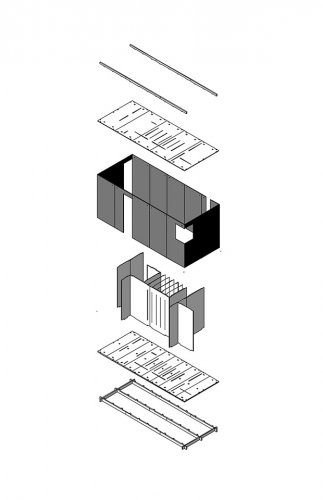
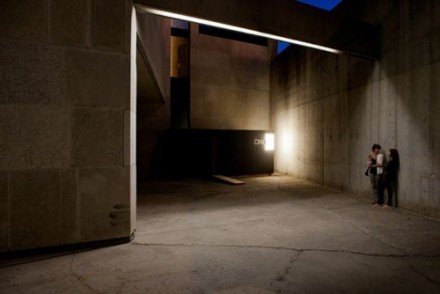
The first version was commissioned by the WNDX Festival, and was a collaboration with designers Tom Evan, Craig Rodemore and Will Vachon. Designed as a labyrinth, it allowed viewers to weave their way past a looping projector toward a viewing platform. A series of strategically placed mirrors projected 16mm films horizontally onto white plexiglass, where the heavily textured, hand-processed films were examined like a map, a post-mortem that references the death of cinema.
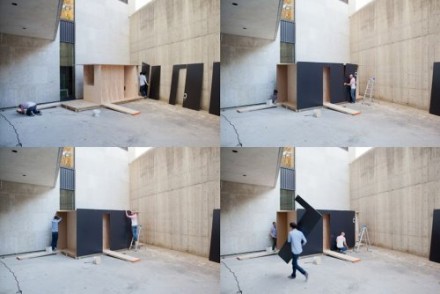
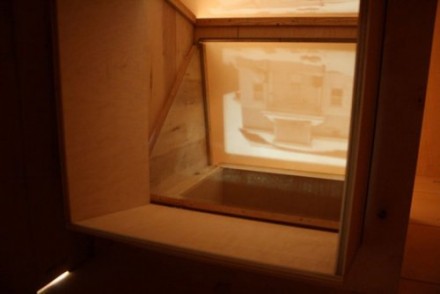
The Situated Cinema was open to pedestrians who chanced upon it, went in and out freely, stayed for longer or shorter visits, were quiet or disruptive: this was an initial opportunity to see what happens when the public space of the city intervenes in the private experience of art—that is, what happens when the private experience of art is disrupted, unsettled, or reframed by the chance encounters and events of the public space of the city?
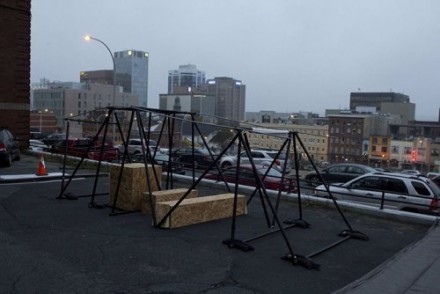
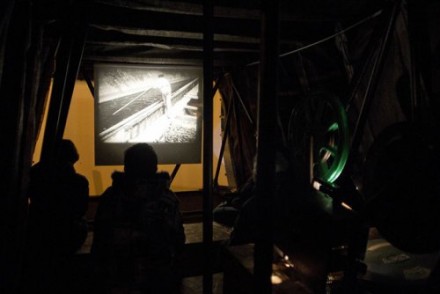
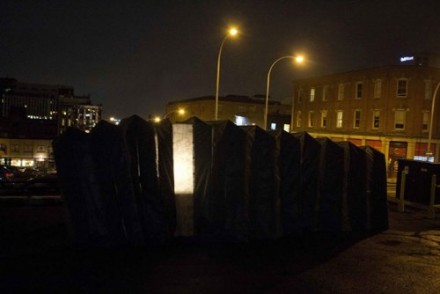
The second iteration of the cinema was designed as an intimate projection space, with tiered seating and a 16mm projection platform that also function as shipping crates. The exterior cladding is modular, and constructed out of light weight fabric and coroplast sheeting. Its sharp angular structure resembles a camera bellow when assembled. Initiated in a free lab, completed by Will Vachon, Samantha Bruegger, Paul Zylstra and Craig Rodmore.
The project’s third iteration, the Sky Cinema at once references the primordial origins of cinema (that of celestial contemplation) and the radical potential of a cinema unrestrained by the conventions of cinematic spectatorship. It was designed in collaboration with Thomas Evans, John Mandeville and Alexandre Larose, and is still in the proposition phase for installation in Halifax.
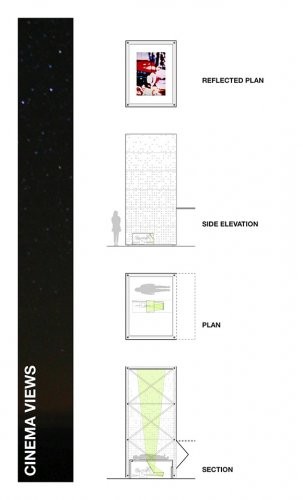
A vertical structure containing a large plinth with a looping 16mm projector, the Sky Cinema refracts light upward, directing the gaze of spectators to the sky. The cinema’s unique cladding creates distinctive daytime and evening effects. During the day, sunlight is filtered into the space through strategically designed permutations, creating an inverted magic lantern—a precursor to the cinematic moving picture. As the city fades into twilight, the cinema is turned on. Flickering celluloid images emanate through the cladding, a light source radically different from ubiquitous nocturnal video displays.
Through the Sky Cinema, multiple points in cinematic history converge, and the artifice of the cinema is exposed. The use of 16mm reveals the mechanics of film-based production and projection, while at the same time, the permeable structure of the cinema alters the normally hermetic experience of spectatorship by introducing the natural sound-scape of the ever-present city. Eyes cast upward, spectators are encouraged to become star-gazers and sky-watchers once again. And in so becoming, they experience the history and tensions of the moving image—a history at once embodied in the cinema itself and reflected in its projections
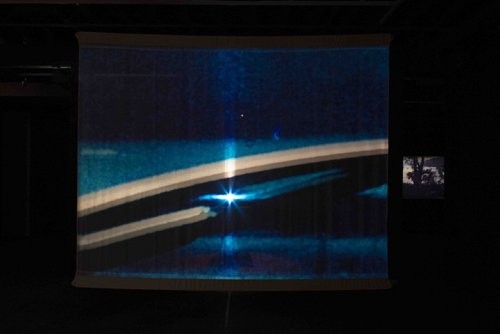
An engagement between architecture and experimental film, the project conceptualizes a new form of spectatorship through an intermingling of the experience of gallery and the relative intimacy of film. To do this, the Situated Cinema reinvented the cinema space as temporary, ephemeral, and rather than self-contained, contained within the gallery. Silent, 16mm and 8mm film loops were situated within the gallery, which was redesigned as contrary cinema spaces within a space. The silence of the films, in conjunction with the relative silence of the gallery, emphasizes and exposes the mechanics of film-based production and projection—revealing that which is so frequently and increasingly obscured, even fetishized.
Situated Cinema is a commissioned collaborative project by myself and Alexandre Larose. Emphasizing and exposing the raw mechanics of film-based production and projection, this immersive installation reveals elements of the filmic process that viewers rarely have the opportunity to experience.
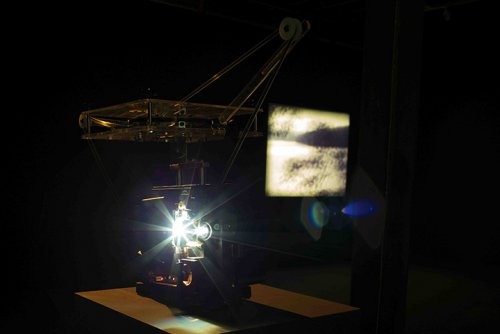
Artspace was reconfigured through the introduction of the site-specific architectural structure in the far-left gallery space. Crawl under the walls and enter this viewing space to experience a 16mm film loop that documents the crumbling walls of a Vaudeville era theatre in Sackville, New Brunswick. Shot exclusively with the natural light that filtered through the open doors and cracked windows of this ruined theatre-cum-cinema space, the artists incorporated open-shutter techniques and experimented with the alchemical properties of the physical photographic film to create this visual document of light within the theatre, the trace of past performances and the layering of a once narrative space.
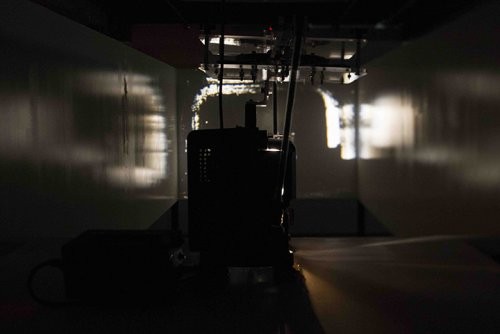
To the far right of this structure two looped projections play repeatedly to re-imagine a deteriorating archive. The films have been transformed over time by basement projections and ad-hoc storage. The two projections marry original found footage film-stock that documents daily family life and 8mm Kodachrome (a very fragile and long obsolete material) that has been analyzed and reframed. The result is a blistering colour flux of deteriorating film material; a celebration of amateur camera gestures, faulty framing, and in-camera edits; a reclamation of the original images and a resetting of their decay.
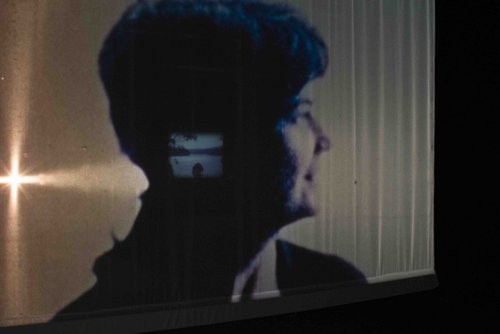
This article was originally published as a French translation on our sister magazine Hors Champ on May-June 2016: http://www.horschamp.qc.ca/spip.php?article638
Notes
- George Simmel, “The Metropolis and Mentality” (1903) in The School of Chicago, Paris, Aubier, 1984, p. 67. ↩
- ibid., 65. ↩
- Roland Barthes, “En sortant du cinema” Communications, vol. 23, no 1, 1975, p. 105. ↩
- Graham, Dan. 1993. “Cinema (1981).” In Rock my religion, 1965-1990. Edited by Brian Wallis, 168-179. MIT Press, 1993. p.178. ↩



